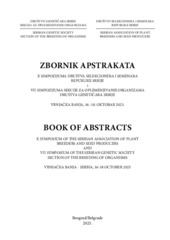Приказ основних података о документу
Razvoj, fiziologija i anatomija nodula na korenu soje
Development, physiology and anatomy of soybean root nodles
| dc.creator | Miladinović, Vladimir | |
| dc.creator | Ugrenović, Vladan | |
| dc.creator | Saljnikov, Elmira | |
| dc.creator | Grujić, Tara | |
| dc.creator | Koković, Nikola | |
| dc.creator | Delić, Dušica | |
| dc.date.accessioned | 2024-04-12T12:44:36Z | |
| dc.date.available | 2024-04-12T12:44:36Z | |
| dc.date.issued | 2023 | |
| dc.identifier.isbn | 978-86-87109-17-9 | |
| dc.identifier.uri | http://RIVeC.institut-palanka.rs/handle/123456789/890 | |
| dc.description.abstract | Izuzetan ekološki i privredni značaj soje je što kao biljka azotofiksator ima sposobnost prevođenja atmosferskog azota u amonijačni oblik dostupan biljkama. Proces se odvija na korenu soje u nodulama koje nastaju u simbiozi biljke i bakterija iz roda Bradhyrhizobium japonicum. Kontakt između biljke i bakterija počinje izlučivanjem u zemljište raznih vrsta polifenola (izoflavona), signalnih jedinjenja koja privlače bakterije. Nakon difuzije izoflavona kroz bakterijsku membranu dolazi do pokretanja Nod faktora bakterije, tj. lipohitooligosaharida pomoću kojih bakterija vrši infekciju korenske dlake. Nakon infekcije započinje obrazovanje azotofiksirajuće nodule u kojoj su svi metabolitički procesi pod potpunom kontrolom biljke. Biološku fiksaciju u noduli vrši enzim nitogenaza u anaerobnim uslovima. Biljka i bakterija zajedno stvaraju jedinjenje leghemoglobin koje vezuje kisonik i omogućava stvaranje anaerobnih uslova koji pogoduju enzimu nitrogenazi vršenje procesa azotofiksacije. Takođe, leghemoglobin aktivnoj noduli daje crvenu boju na poprečnom preseku. Anatomska građa aktivne nodule predstavljena je strukturno sa tri različite zone. Najveću zonu čini centralni deo, tj. tkivo inficirano bakterijama (rizobijum polje), a na njega se naslanja unutrašnja kora (korteks) i spoljašnja kora (eksterni korteks). Prve nodule počinju da vrše azotofiksaciju u fazi razvoja soje „dve troliske“(V2) ili „tri roliske“(V3), da bi najveći broj aktivnih nodula bio u fenofazi „početak formiranja semena“ (R5). Prosečna aktivnost nodula traje 30-40 dana. O ovim procesima postoji dosta naučnih saznanja, međutim i dalje postoji dosta prostora za rasvetljavanje odnosa biljka soje i bakterija Bradhyrhizobium japonicum, a sve u funkciji dobrobiti koje oni donose poljoprivrednoj proizvodnji. | sr |
| dc.description.abstract | The exceptional ecological and economic importance of soybeans is that, as a nitrogen-fixing plant, it has the ability to convert atmospheric nitrogen into an ammonia form available to plants. The process takes place on soybean roots in nodules that are formed in the symbiosis of the plant and bacteria from the genus Bradhyrhizobium japonicum. The contact between the plant and the bacteria begins with the excretion into the soil of various types of polyphenols (isoflavones), signal compounds that attract the bacteria. After the diffusion of isoflavones through the bacterial membrane, the Nod factor of the bacteria is activated, i.e. of lipochitooligosaccharides with which the bacterium infects the root hair. After infection, the formation of a nitrogen-fixing nodule begins, in which all metabolic processes are under the complete control of the plant. Biological fixation in the nodule is carried out by the enzyme nitrogenase under anaerobic conditions. Together, the plant and the bacteria create the compound leghemoglobin, which binds oxygen and enables the creation of anaerobic conditions that favor the nitrogenase enzyme for the nitrogen fixation process. Also, leghemoglobin gives the active nodule a red color on cross-section. The anatomical structure of the active nodule is represented structurally by three different zones. The largest zone is the central part, i.e. tissue infected with bacteria (rhizobium field), and the inner bark (cortex) and the outer bark (external cortex) rest on it. The first nodules begin to carry out nitrogen fixation in the stage of soybean development “two trefoils” (V2) or “three trefoils” (V3), so that the largest number of active nodules would be in the phenophase “the beginning of seed formation” (R5). Average nodule activity lasts 30 to 40 days. There is a lot of scientific knowledge about these processes, but there is still a lot of room for improvement elucidating the relationship between the soybean plant and bacteria Bradhyrhizobium japonicum, all in function of the benefits they bring to agricultural production. | sr |
| dc.language.iso | sr | sr |
| dc.language.iso | en | sr |
| dc.publisher | Beograd : Društvo genetičara Srbije | sr |
| dc.rights | openAccess | sr |
| dc.source | X simpozijum Društva selekcionera i semenara Republike Srbije i VII simpozijum Sekcije za oplemenjivanje organizama društva genetičara Srbije Vrnjačka Banja, 16.-18. Oktobar 2023. | sr |
| dc.subject | soja | sr |
| dc.subject | nodule | sr |
| dc.subject | izoflavoni | sr |
| dc.subject | azotofiksacija | sr |
| dc.subject | Bradhyrhizobium japonicum | sr |
| dc.subject | soybean | sr |
| dc.subject | nodul | sr |
| dc.subject | isoflavones | sr |
| dc.subject | nitrogen fixation | sr |
| dc.title | Razvoj, fiziologija i anatomija nodula na korenu soje | sr |
| dc.title | Development, physiology and anatomy of soybean root nodles | sr |
| dc.type | conferenceObject | sr |
| dc.rights.license | ARR | sr |
| dc.citation.epage | 120 | |
| dc.citation.spage | 119 | |
| dc.identifier.fulltext | http://RIVeC.institut-palanka.rs/bitstream/id/2836/2 Miladinovic.pdf | |
| dc.identifier.rcub | https://hdl.handle.net/21.15107/rcub_rivec_890 | |
| dc.type.version | publishedVersion | sr |


